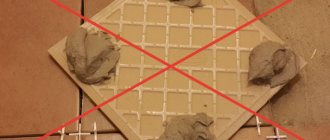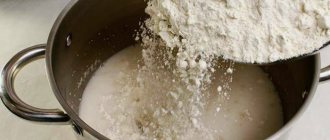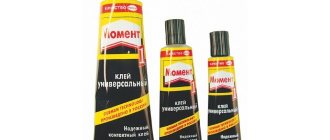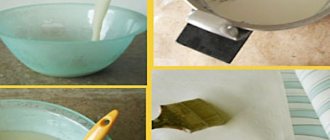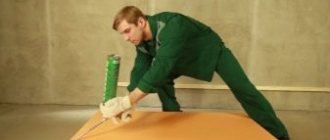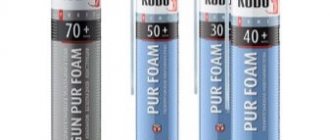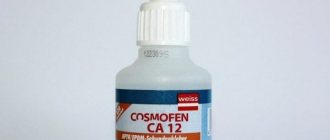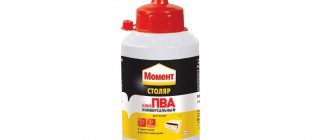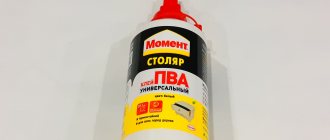Description and features
Foam adhesive is an adhesive mass based on polyurethane. Polyurethane adhesive is a good alternative to cement joints used to fix slabs. Areas of application of foam adhesive:
- connection of polystyrene insulation;
- foam concrete fixation;
- fastening plasterboard slabs;
- gluing wood and stone cladding;
- strengthening window sills;
- insulation.
Foam adhesive is used to strengthen insulating surfaces. With its help, starting strips and bars are installed. It helps fix the boards on the floors. Foam adhesive is used for fixing insulating polystyrene foam materials to various substrates: ceramic tiles, concrete, brick.
Expanded polystyrene "TechnoNIKOL"
Used for gluing expanded polystyrene boards, good for creating thermal insulation properties. Contains a ten percent polyurethane component.
The foam is suitable for attaching polystyrene foam elements to buildings from both the outside and the inside, for insulating basements and foundations. Capable of filling cracks, holes, and joint boundaries of slabs.
The technical characteristics differ only in the point of setting with the part (15 minutes) and the color after drying (grayish).
In general, Technonikol is suitable for polystyrene foam elements and attaching other materials, but the manufacturer of 500 Professional advises applying the foam-adhesive composition in accordance with the main purpose of use.
Main characteristics
Adhesive foam based on polyurethane is a modern material. It allows you to fix foam boards when performing external and internal work. The fixation he makes is durable and reliable. The adhesive composition ensures strength and high quality finishing.
Main technical characteristics of adhesive foam:
- High adhesion. This quality ensures excellent adhesion of dissimilar bodies.
- Moisture-proof and water-resistant. Allows the use of foam adhesive for both external and internal work.
- Good thermal insulation. This is an additional bonus when insulating the facade and walls of a building.
There are no toxic substances or freons among the ingredients of the foam adhesive. This suggests that the adhesive is completely safe for human life and health.
What is adhesive foam
Foam adhesive for polystyrene foam was developed not so long ago, but quickly became in demand due to its good properties. The composition can be used to secure polystyrene inside and outside the building; the adhesion will be of high quality, strength and long service life.
Foam adhesive for polystyrene foam has the following distinctive properties:
- High level of adhesion;
- Moisture-repellent property;
- Thermal insulating property.
Freons are not used as components; for this reason, the products are harmless to human health and nature.
The composition can be used to secure polystyrene inside and outside the building.
How is it different from polyurethane foam?
Polyurethane foam or adhesive foam? It is difficult for an ignorant person to understand. To understand the difference between these materials, you need to compare them. Polyurethane foam is a polyurethane sealant. Purpose: installation. Additionally, it has sound-proofing and heat-insulating properties. Used when installing doors, sealing cracks, sealing seams. It can be used to fix building materials, but the expansion it gives when hardening makes fixation problematic.
See also
Instructions for use of TechnoNIKOL adhesive foam, description and consumption features
Adhesive foam is a polyurethane adhesive. Its main function is to connect parts. It differs from polyurethane foam in its qualities. Its adhesive ability and adhesion are many times better than polyurethane foam. This is achieved through special additives. Foam adhesive does not expand. Its increase in volume is minimal. In order to evenly glue the panel to the wall with mounting foam, additional fixation is needed. Otherwise, the foam, expanding, will raise the slab. When working with foam adhesive, no fixing devices are required. The panel is simply applied to the wall and pressed.
An adapter tube is included with the mounting foam. Foam glue is a professional building material. To use it you need a pistol.
Installation of insulation using foam glue
If you decide to glue the insulation using adhesive foam, then you can do the installation yourself. To do this, just do the following:
- Make sure that the air temperature does not exceed +35 degrees and not lower than 0. Some formulations indicate a more precise range at which the adhesive solution is recommended to be applied.
- Remove the protective cap from the cylinder and insert it into the gun so that the valve is at the top.
- Shake the gun with the cylinder forcefully (about 20 times).
- Step back about 20 mm from the edge of the polystyrene foam board and apply glue around the perimeter of the product. After this, you need to move the gun diagonally.
- Place the board on the surface with the side on which the glue is applied. You need to press the product (without force) for 5 minutes, this time is enough for the foam to expand as much as possible.
- Make sure that the plate is fixed level. If the insulation is crooked, then you need to straighten it. The glue sets in 20 minutes, so you have plenty of time to make adjustments.
- The distance between the plates should be about 2 mm. In order for the gaps to be even, it is necessary to use special plastic crosses for the seams.
- If in some areas it was not possible to maintain the required distance and cold bridges formed, then the space can be filled either with a piece of polystyrene foam or with glue, the excess of which can be easily removed after the foam has dried.
Some experts increase the adhesion strength of the foam to the surface being treated using spacer dowels. If you decide to use them, then installation can only be done 2 hours after applying the foam.
Advantages and disadvantages
Foam adhesive has its advantages and disadvantages. The advantages of foamed adhesive composition include:
- Economical - one cylinder is enough for 12 meters.
- Convenience - the adhesive composition is sold ready-made.
- Ease of use. The glue is applied from a bottle. The remains are cut off.
- Rapidity. The glue hardens much faster than polyurethane foam.
- Minimal extension.
- Excellent adhesion.
- Environmentally friendly. There are no harmful substances in the composition.
The disadvantages include:
- high price;
- the need for additional devices - glue-foam is supplied through a construction gun.
The advantages of foam glue successfully cover all its disadvantages. It is much better and more reliable to glue foam panels with it than with polyurethane foam.
Criterias of choice
When choosing a foam adhesive, you should pay attention to its performance qualities. The adhesive composition is used for interior and exterior work. This suggests that it should interfere with heat transfer. Speed is important for work. The sooner the composition is in place, the faster finishing work can continue. Adhesive for polystyrene foam must have good adhesion. The better the grip, the better the work. An equally important quality is consistency. The distribution of glue over the surface largely depends on the consistency.
Consistency
Consistency is the state of liquid and solid bodies, determined by their density. Substances with high density are thick. During the gluing process, this interferes with good distribution of the composition and increases its consumption. A substance with low density will spread. This will make the work poor quality. A good adhesive foam has a light consistency, medium thickness and a hardening density of about 25 g/cm3.
Vapor tightness
Vapor permeability is the ability of a material to pass or retain water vapor. Quality is very important for insulation and finishing of buildings. If the finishing material is vapor-permeable, then this is a threat to its fragility. The settling of water vapor on the surface leads to the formation of mold. The best option is considered to be a moisture-repellent material on the surface of which condensation does not accumulate. Many adhesives have this quality. Adhesive foam is no exception.
See also
Requirements and characteristics of adhesive for ceiling tiles, review of the best compositions
Frost resistance
Frost resistance is the ability of a material to withstand repeated freezing and thawing. In construction, this parameter evaluates how a material retains its operational properties under the influence of moisture and low temperatures. Adhesive foam has this quality to the fullest. It can withstand temperature changes for many years.
Composition requirements
Composition is of great importance in assessing the quality of building materials. Not only operational capabilities, but also people’s health depend on it. Adhesive compositions should be odorless. The presence of toxic substances in their composition is unacceptable. The composition of polyurethane glue should not contain carbon dioxide and freon. These substances are harmful to health.
Setting period
The setting period is an important performance indicator for the adhesive mass. The speed of work depends on it. The setting period refers to the time between the connection of parts and their primary adhesion. The setting period of the foam adhesive is 10-15 minutes. This is a relatively short period of time.
Hitch level
When gluing, glue particles penetrate both materials, connecting them. The glued materials form a kind of sandwich, in the middle of which there is an adhesive composition. Substances are added to the adhesive foam that increase its surface energy and help moisturize the working surface. Due to this, foam adhesive is widely used for fixing various materials.
Description of TechnoNIKOL 500 Professional
This type of “Technonikol” refers to a universal product. Foam adhesive is quite popular and is characterized by good durable properties of its constituent elements and excellent adhesive properties to all materials.
Good for extruded polystyrene foam, in particular for tiled structures made from it, they have thermal insulation.
Glue is used to remove joint boundaries located between the tile spaces, and is also suitable for insulation purposes in roofing, foundation, basement, plinth work, on the outside and inside of houses.
Professional foam will also fill small holes, chips in the wall, and fix panel and plasterboard elements.
Perfect for filling cavities and voids, as well as for gluing tiles and other small parts, such as stucco molding, baseboards, and cladding.
Glue - foam is a universal one, therefore it is suitable for various materials, including chipboard, tile, plaster, and porcelain stoneware elements.
Let us list the main characteristics of the adhesive - foam:
- has a thermal conductivity of 0.035 W/μ;
- sets to the surface in about 10 minutes;
- has a glue layer density of 25 g/cm3;
- dries within 24 hours;
- has a bluish color after drying;
- the best microclimate parameters are temperature 0 - +35 C, humidity no more than 55 percent;
- adhesive properties to extruded polystyrene foam - 0.13 MPa, concrete and wooden materials - 0.15 MPa, metal - 0.07 MPa.
If it is necessary to correct the location of the glued object, this can only be done within 10 minutes.
Review of brands and manufacturers
Construction stores sell adhesive foam from various manufacturers. Samples differ in price and quality. The highest quality, but also the most expensive options are produced in Germany and Finland. You definitely shouldn’t buy foam adhesive made in China. But between these manufacturers there is also a wide range of products from other suppliers.
T-Vanguard
T-Avangard combines polystyrene foam with concrete and brick. With its help, you can lay insulation on a wall covered with gypsum putty. The compositions are available in seasonal versions. They differ in temperature requirements. The disadvantage of the adhesive is that it is sold in powder form. Before use, the glue is diluted with water.
Tytan Styro 753
Adhesive foam is packaged in cylinders. A distinctive feature is quick setting and complete drying. You can continue grinding and other installation work a couple of hours after laying the slabs.
Ceresit ST 83
Ceresite is sold in bags. This is a powdery mixture. Package weight – 25 kg. The powder is diluted with water. Breeding instructions are on the package.
See also
Description and properties of Titebond brand wood glue, rules of use
TechnoNIKOL
TechnoNIKOL adhesive foam is used for fixing XPS and EPS boards for external insulation and interior work. They seal the cracks and glue polystyrene foam. The glue is moisture resistant. He is not afraid of mold. The composition has high adhesion to concrete and other materials. A cylinder with a capacity of 750 mm is enough for 12 m of working surface.
Macroflex
Macroflex adhesive foam is available in cylinders. There are two types of glue: for summer and for winter. The disadvantage is the large expansion. Macroflex 65, expanding, is capable of doubling its size. Other brands of this glue expand less at low temperatures.
When choosing adhesive foam, you should take into account environmental conditions and types of finishing materials.
Subtleties of application
When working with foam glue, you must adhere to the following algorithm:
- Before work, read the instructions for use of the composition. It is especially important to adhere to the air temperature indicated on the packaging.
- The cap is removed from the cylinder. The cylinder is installed in the gun.
- The installed container should be shaken well.
- The perimeter of the PVC slab is first covered with foam adhesive. This is done with a distance of 20 cm from the edge. Next, the adhesive composition is distributed diagonally.
- An object with an adhesive composition applied to it is pressed against the work surface and held for 5 minutes.
- After this period, check the evenness of the installation. If necessary, the masonry is corrected.
Any gaps that arise can be filled with glue. At the same time, consumption increases.
Useful tips
There are several details to consider when purchasing foam adhesive:
- Good quality glue cannot be liquid. You can check this indicator in large construction stores, as they have special “testers”. Squeeze out a little solution and evaluate the consistency.
- With a cylinder volume of approximately 800 ml, a consumption of approximately 125 ml per 1 square meter is considered normal. The density of the composition causes its increased consumption during work, so this indicator must be taken into account when choosing.
- Resistance to low temperatures allows you to work with foam glue in the cold; the conditions of use must be listed on the label. Such compositions are usually resistant to high temperatures.
- Take a closer look at the components contained in the glue. There should be no impurities of carbon dioxide and freon. It is good if the composition contains isocyanate oligomers.
- The glue setting time should be 10-15 minutes.
- The lowest degree of adhesion relative to a concrete surface should be 0.3 MPa, regarding foam plastic boards - at least 0.8 MPa.
Air circulation between the wall and the thermal insulation is unacceptable, since in this case there will be no effect from the work performed. The foam or polystyrene boards must fit snugly against the wall. The simplest and fastest way to fix the insulation is to use foam adhesive.
